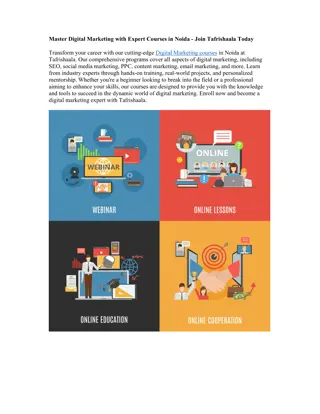Importance of Marketing in the Twenty-First Century
The first decade of the twenty-first century presented challenges for firms to thrive in a tough economic environment, emphasizing the pivotal role of marketing in driving financial success. Marketers shape demand, create opportunities, and navigate a rapidly evolving landscape to make critical decisions on product design, pricing, distribution, and promotional strategies. Marketing is about meeting human needs profitably, understanding customers deeply, and engaging in exchanges that deliver value to all stakeholders. Various entities, such as goods, services, experiences, and ideas, are marketed by professionals seeking to influence consumer behavior and manage demand effectively.
Download Presentation

Please find below an Image/Link to download the presentation.
The content on the website is provided AS IS for your information and personal use only. It may not be sold, licensed, or shared on other websites without obtaining consent from the author.If you encounter any issues during the download, it is possible that the publisher has removed the file from their server.
You are allowed to download the files provided on this website for personal or commercial use, subject to the condition that they are used lawfully. All files are the property of their respective owners.
The content on the website is provided AS IS for your information and personal use only. It may not be sold, licensed, or shared on other websites without obtaining consent from the author.
E N D
Presentation Transcript
By Aseptiana Parmawati,S.Pd.,M.Pd.
MARKETING FOR THE TWENTY FIRST CENTURY A. The Importance of Marketing The first decade of the twenty first century challenged firms to prosper financially and even survive in the face of an unforgiving economic environment. Marketing is playing a key role in addressing those challenges. Finance, operations, accounting, and other business functions won t really matter without sufficient demand for products and services so the firm can make a profit.
Financial successoften depends on marketing ability. Successful marketing builds demand for products and services, creates jobs.
Marketers must decide what features to design into a new product orservice, what prices to set, where to sell products or offer services, and how much to spend on advertising, sales, the internet, or mobile marketing. They must make those decisions in an internet-fueled environment where consumers, technology, and economic forces change rapidly, and the consequences of the marketer s words and actions can quickly multiply. competition,
B. The Scope of Marketing 1. What is Marketing? Marketing is about identifying and meeting human and social needs (meeting needs profitably) The American Marketing following formal definition : Marketing is the activity, set of institutions, and communicating, delivering, and exchanging offerings that have value for customers, clients, partners, and society at large. Association offers the processes for creating,
The aim of marketing is to know and understand the customer so well that the product or service fits him and sells itself.
2. What is Marketed? Marketers market 10 main types of entities: 1. Goods 2. Services 3. Events 4. Experiences 5. Persons 6. Places 7. Properties 8. Organizations 9. Information 10. ideas
3. Who Markets? Marketers and Prospects A marketer is someone who seeks a response-attention, a purchase, a vote, a donation-from another party, called the prospect. a. If two parties are seeking to sell something to each other, we call them both marketers. Marketers are responsible for demand management. They seek to influence the level, timing, and composition of demand to meet the organization s objectives.
Eight demand states are possible: Negative demand : consumers dislike the product and may even pay to avoid it. a. Nonexistent demand : consumers may be unaware of or uninterested in the product. b. Latent demand : consumers may share a strong need that cannot be satisfied by an existing product. c. Declining demand : consumers begin to buy the product less frequently or not at all. d. Irregular demand : consumers purchases vary on a seasonal, monthly, weekly, daily, or even hourly basis. e. Full demand : consumers are adequately buying all products put into the marketplace. f. Overfull demand : more consumers would like to buy the product than can be satisfied. g. Unwholesome demand : consumers may be attracted to products that have undesirable social consequences. h.
2. Markets Traditionally , a market was a physical place where buyers and sellers gathered to buy and sell goods. Five basic markets and their connecting are describe as follows : manufacturers go to resource markets (raw material markets, labor markets, money markets), buy resources and turn them into goods and services, and sell finished products to intermediaries , who sell them to consumers. Consumers sell their labor and receive money with which they pay for goods and services. The government collects tax revenues to buy goods from resource, manufacturer, and intermediary markets and uses these goods and services to provide public services. Each nation s economy, and the global economy, consists of interacting sets of markets linked through exchange processes.























